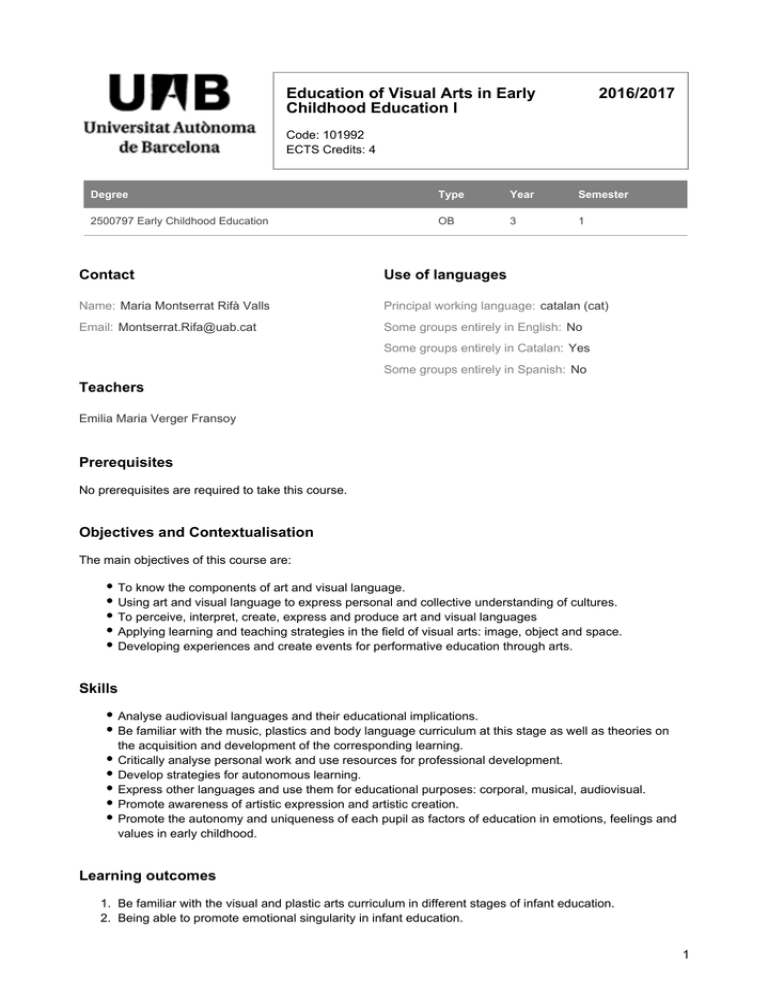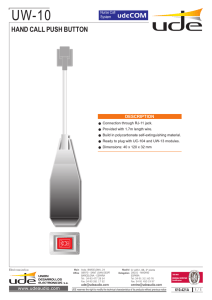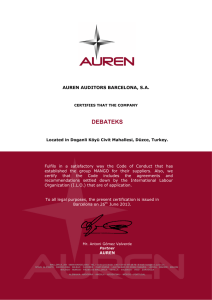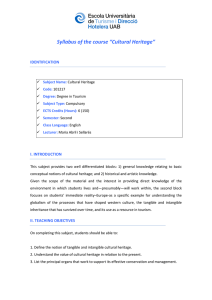Education of Visual Arts in Early Childhood Education I
Anuncio

Education of Visual Arts in Early Childhood Education I 2016/2017 Code: 101992 ECTS Credits: 4 Degree Type Year Semester 2500797 Early Childhood Education OB 3 1 Contact Use of languages Name: Maria Montserrat Rifà Valls Principal working language: catalan (cat) Email: Montserrat.Rifa@uab.cat Some groups entirely in English: No Some groups entirely in Catalan: Yes Some groups entirely in Spanish: No Teachers Emilia Maria Verger Fransoy Prerequisites No prerequisites are required to take this course. Objectives and Contextualisation The main objectives of this course are: To know the components of art and visual language. Using art and visual language to express personal and collective understanding of cultures. To perceive, interpret, create, express and produce art and visual languages Applying learning and teaching strategies in the field of visual arts: image, object and space. Developing experiences and create events for performative education through arts. Skills Analyse audiovisual languages and their educational implications. Be familiar with the music, plastics and body language curriculum at this stage as well as theories on the acquisition and development of the corresponding learning. Critically analyse personal work and use resources for professional development. Develop strategies for autonomous learning. Express other languages and use them for educational purposes: corporal, musical, audiovisual. Promote awareness of artistic expression and artistic creation. Promote the autonomy and uniqueness of each pupil as factors of education in emotions, feelings and values in early childhood. Learning outcomes 1. Be familiar with the visual and plastic arts curriculum in different stages of infant education. 2. Being able to promote emotional singularity in infant education. 3. Being able to use expressive languages of an artistic nature for educational purposes. 1 3. 4. 5. 6. Being able to use expressive languages of an artistic nature for educational purposes. Having the capacity for self-criticism in the carrying out of the professional activity. Having the resources to promote artistic sensitivity and creativity. Know the basics of the corporal expression curriculum at this stage as well as theories on the acquisition and development of relevant learning. 7. Master audiovisual languages for use in education. 8. Organising the autonomous part of learning in the visual and plastic sphere effectively and productively. 9. Using different languages (body, music and audio-visual) to express the learning acquired in the subject. Content Section I. CULTURAL DIMENSION: Art and education foundations 1.1. Arts education in the human development of the person. 1.2. Relations between art and education. 1.3. Historical, social and cultural contexts 1.3.1. The audiovisual society. 1.4. Artworks as a source of knowledge 1.4.1. Perception, representation and interpretation of art. Section II. PRODUCTIVE DIMENSION: Training in the practice of art 2.1. Visual thinking and artistic development: creative processes. 2.2. Practices and projects related to different cultural contexts and artistic movements. 2.3. Understanding and experimenting with the practice of art as a process of knowledge. Methodology Autonomous Students will perform a theoretical and practical part of the course independently, will be agreed during the classes. Reading texts on the cultural dimension Design and artistic creation: art and visual language Theoretical Reflections: art and education. Whole group attendance Presentations by teachers of content and key issues of the syllabus. It is done with the whole group class and allows exposure of the main content through an open and active participation by students. Planning and organization of exercises and activities to be held later in seminars. Collective artistic activities: trips / visits (museums, art exhibitions ...), conferences, audiovisual ... Seminars Workshops in small groups supervised by teachers where there will be proposals specific to the area: individual and group. Delves into the contents and themes worked in the large group. 2 Reflections from the texts and screenings of audiovisual documents related to the matter. Working process of artistic creation: analysis of processes and results. Supervised Tutoring or small groups to follow up the proposals. The sessions of this course are based on research and experimentation with materials by students, which requires an investigation based on image documentation and of the recycling of materials for art education. Moreover, the methodology adopted requires for a good development that students bring to the classroom specialised materials for the developing of art activities (brushes and paints, among others). Teachers will recommend the most suitable material for planned activities, which will have a sustainable cost and can be shared among students. We will search for mechanisms to ensure that the student can have it in case you do not have the necessary resources. Activities Title Hours ECTS Learning outcomes Seminars 25 1 1, 7, 2, 3, 4, 5 Whole attendance group 8 0.32 1, 7, 2, 3, 4, 5 10 0.4 1, 7, 3 Design and art studio: art and visual language 30 1.2 8, 4, 5 Theoretical reflections: art and education 27 1.08 8, 2, 3, 5 Type: Directed Type: Supervised Tutoring sessions and other activities Type: Autonomous Evaluation There will be continuous assessment; and attendance is compulsory: the student must attend at least 80% of classes, otherwise it will be considered absent. Throughout the course there will be two deliveries of works: . the first in November . the second, a week after the last class session. The final portfolio is the latest delivery (content and presentation will be assessed). The teacher will specify the assigments to be delivered, the format and the exact date of deliveries. During the three weeks following the delivery of evidence, we will inform students of their marks (virtual campus) and we will specify a date for the revision of the marks and feedback for the assignments. To pass this course, the student should demonstrate a good general communicative competence, both orally and in writing and a good knwoledge of the language or vehicular languages reflected in the syllabus. More information: http://www.uab.cat/web/informacio-academica/avaluacio/normativa-1292571269103.html 3 Evaluation activities Learning outcomes Title Weighting Hours ECTS Activities based on readings and viewings (Section I. Art and Education. CULTURAL DIMENSION 30% 0 0 1, 6, 7, 5, 9 Art education portfolio (Section I and II) 20% 0 0 8, 2, 3, 4, 9 Bidimensional and tridimensional art studio practices (Section II. Training in Art studio) 50% 0 0 3, 5 Bibliography Albers, J. (1963). La interacción del color. Madrid: Alianza. Acaso, M. (2009). La educación artística no son manualidades. Nuevas prácticas en la enseñanza de las artes y la cultura visual. Madrid: Catarata. Berger, R. (1976). El conocimiento de la pintura. Barcelona: Noguer. Berger, J. (2001). Modos de ver. Barcelona: Gustavo Gili. Bamford, A. (2009). El factor ¡wuau!. El papel de las artes en la educación. Barcelona: Octaedro. De Bartolomeis, F.(1994). El color de los pensamientos y de los sentimientos. Barcelona: Ediciones Octaedro, S.L. De Grandis, L. (1985). Teoría y uso del color. Madrid: Cátedra. Edwards, B. (1994). Aprender a dibujar con el lado derecho del cerebro. Barcelona: Urano. Efland, A. (1979). Arte y percepción visual. Madrid: Alianza. - (1993). Consideraciones sobre la educación artística. Barcelona: Paidós. - (2002). Una historia de la educación del arte. Tendencias intelectuales y sociales en la enseñanza de las artes visuales. Barcelona: Paidós. - (2004). Arte y cognición. La integración de las artes visuales en el currículum. Barcelona: Octoedro. Efland, A.; Freedman, K.; Sruhs, P. (2003). La educación y el arte posmoderno. Barcelona: Paidós. Eisner, E. W. (1995). Educar la visión artística. Barcelona: Paidós. - (1998). El ojo ilustrado. Indagación cualitativa y mejora de la práctica educativa. Barcelona: Paidós. - (2004). El arte y la creaciónde la mente. Barcelona: Paidós. Gardner, H. (1994). Educación artística y desarrollo humano. Paidós: Barcelona. - (1999). Inteligencias múltiples. La teoría en la práctica. Barcelona: Paidós. - (2000). La educación de la mente y el conocimiento de las disciplinas. Barcelona: Paidós. Gombrich, E. H. (1980). Historia del arte. Madrid: Alianza. Grosenick, U. (ed) (2001). Mujeres artistas de los siglos XX y XXI. Colonia: Taschen. 4 Grosenick, U. (ed) (2001). Mujeres artistas de los siglos XX y XXI. Colonia: Taschen. Hayes, C. (1986). Guía completa de pintura y dibujo. Madrid: Hermann Blume. Malins, F. (1983). Para entender la pintura. Madrid: Hermann Blume. - (1983): Mirar un cuadro: para entender la pintura. Madrid: Hermann Blume. Moreno, T. (1996). El color. Historia, teorías y aplicaciones. Barcelona: Ariel. Witgenstein, L. (1994). Observaciones sobre los colores. Barcelona: Paidós. Wöfflin, H. (1989). Conceptos fundamentales en la Historia del Arte. Madrid: Espasa Calpe. Webs d'interès, pel·licules i documentals audiovisuals Art Education from Democratic Life. www.naea-reston.org/olc/pub/NAEA/home/ A Critical Enlaces Tool Kit. El aprendizaje de las Artes y conocimientos académicos del estudiante y desarrollo social. www.aep-arts.org/resources/toolkits/criticallinks/ Conferencia Mundial sobre la Educación Artística: construir capacidades creativas para el siglo XXI. Hoja de rutapara la Educación Artística. (2006) http://portal.unesco.org/culture/es/ev.php-URL_ID=39546&URL_DO=DO_TOPIC&URL_SECTION=201.html Curriculum Educació Infantil. http://www9.xtec.cat/web/curriculum/infantil Iwai, K. (2003). La contribución de la educación artística en los niños. http://www.ibe.unesco.org/publications/Prospects/ProspectsPdf/124s/iwas.pdf Morón, M. (2005). L'art del segle XX a l'escola. http://www.xtec.cat/~mmoron Olaya, O. L. (2006). Defensa de la educación artística, compromiso de todos los sectores educativo, artístico y cultural. http://portal.unesco.org/culture/en/files/30179/11415069571olga_olaya_lucia.pdf/olga%2Bolaya%2Blucia.pdf. Organización de las Naciones Unidas para la Educación, la Ciencia y la Cultura. UNESCO. http://www.unesco.org/es/education Vilasdebó, C. (1961). Alexander Calder: Le Cirque de Calder (1927). http://www.youtube.com/watch?v=MWS96nzFUks Riedelsheimer, T. (2001). Ríos y Mareas: Andy Goldsworthy y la obra del tiempo. http://blueboyspain.wordpress.com/2008/08/23/rios-y-mareas-andy-goldsworthy-el-arte-efimero-de-la-naturaleza/ La ciudad de la pintura. http://pintura.aut.org/ 5


